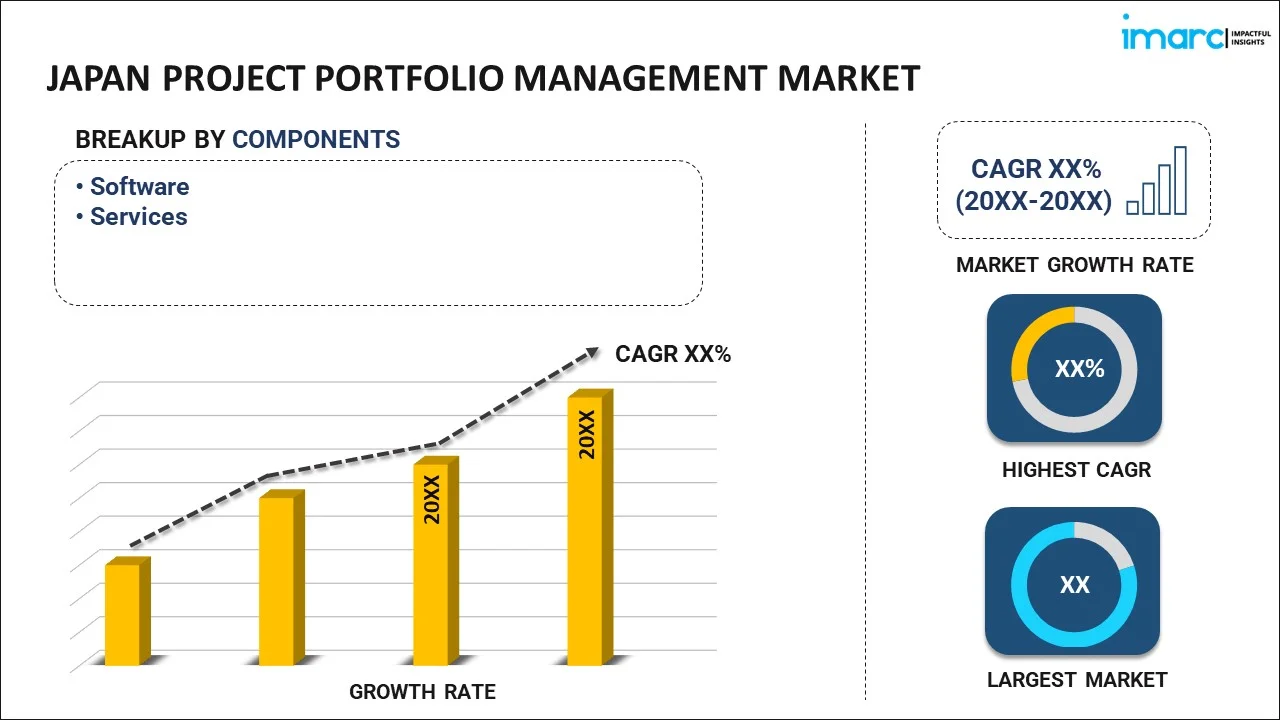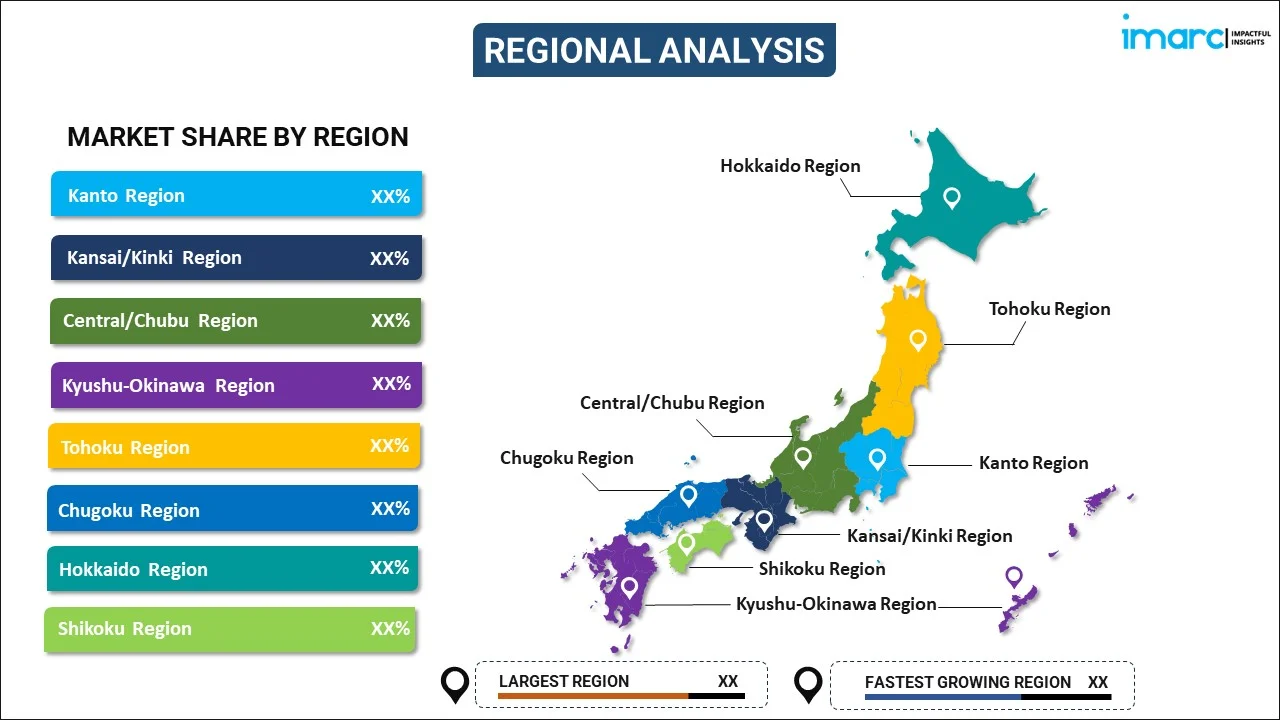
Japan Project Portfolio Management Market Report by Component (Software, Services), Solution Type (Information Technology Solutions, New Product Development Solutions, and Others), Deployment Type (On-premises, Cloud-based), Organization Size (Large Enterprises, Small and Medium Enterprises), Vertical (Energy and Utilities, Government and Defense, IT and Telecom, Banking, Financial and Insurance Services, Manufacturing, Healthcare and Life Science, Consumer Goods and Retail, and Others), and Region 2025-2033
Market Overview:
Japan project portfolio management market size reached USD 402.0 Million in 2024. Looking forward, IMARC Group expects the market to reach USD 1,418.0 Million by 2033, exhibiting a growth rate (CAGR) of 15% during 2025-2033. Government’s commitment to technological innovation, the rising need to manage increasingly complex projects, a focus on sustainability, an aging population's demand for efficient healthcare PPM, surging trend of remote working, stringent regulatory requirements, and the imperative for data-driven decision-making are fueling the market growth.
|
Report Attribute
|
Key Statistics
|
|---|---|
|
Base Year
|
2024 |
|
Forecast Years
|
2025-2033
|
|
Historical Years
|
2019-2024
|
| Market Size in 2024 | USD 402.0 Million |
| Market Forecast in 2033 | USD 1,418.0 Million |
| Market Growth Rate (2025-2033) | 15% |
Project portfolio management (PPM) is a strategic process that organizations use to effectively manage a collection of projects and initiatives to achieve their business objectives. It involves the systematic selection, prioritization, and oversight of projects within a portfolio to optimize resource allocation and ensure alignment with the company's strategic goals. The primary purpose of PPM is to ensure that an organization's resources are allocated to the most valuable and strategically aligned projects. It helps in avoiding duplication of efforts, optimizing resource utilization, and reducing the risk of project failure. By centralizing project management decisions, PPM enables organizations to make informed choices about which projects to pursue, allocate resources effectively, and ensure that projects contribute to the overall success of the business. There are several advantages to implementing PPM, such as it provides visibility and transparency into the entire project portfolio, allowing stakeholders to make informed decisions. It also helps in identifying and mitigating risks early, reducing the likelihood of project failures. Additionally, it promotes better resource allocation, leading to cost savings and improved project delivery.
Japan Project Portfolio Management Market Trends:
The Japan project portfolio management market is influenced by several key drivers, such as the country's commitment to technological innovation and digital transformation. Moreover, the increasing complexity of projects necessitates robust PPM tools and methodologies to ensure successful execution, which is stimulating the market growth. In line with this, a growing emphasis on sustainability and environmental considerations has led to the integration of eco-friendly project management practices into PPM frameworks, which is propelling the market growth. Additionally, Japan's aging population has fueled the demand for PPM in the healthcare and elderly care sectors to optimize resource allocation and improve service delivery, which is propelling the market growth. Apart from this, globalization and international collaborations have escalated the need for PPM to align projects with global standards and requirements, which is facilitating the market growth. Furthermore, the COVID-19 pandemic has accelerated the adoption of remote work and virtual collaboration, making PPM tools indispensable for managing projects across dispersed teams, which is accelerating the market growth across the country.
Japan Project Portfolio Management Market Segmentation:
IMARC Group provides an analysis of the key trends in each segment of the market, along with forecasts at the country level for 2025-2033. Our report has categorized the market based on component, solution type, deployment type, organization size, and vertical.
Component Insights:

- Software
- Services
The report has provided a detailed breakup and analysis of the market based on the component. This includes software and services.
Solution Type Insights:
- Information Technology Solutions
- New Product Development Solutions
- Others
A detailed breakup and analysis of the market based on the solution type have also been provided in the report. This includes information technology solutions, new product development solutions, and others.
Deployment Type Insights:
- On-premises
- Cloud-based
The report has provided a detailed breakup and analysis of the market based on deployment type. This includes on-premises and cloud-based.
Organization Size Insights:
- Large Enterprises
- Small and Medium Enterprises
A detailed breakup and analysis of the market based on the organization size have also been provided in the report. This includes large enterprises and small and medium enterprises.
Vertical Insights:
- Energy and Utilities
- Government and Defense
- IT and Telecom
- Banking, Financial and Insurance Services
- Manufacturing
- Healthcare and Life Science
- Consumer Goods and Retail
- Others
The report has provided a detailed breakup and analysis of the market based on vertical. This includes energy and utilities, government and defense, IT and telecom, banking, financial and insurance services, manufacturing, healthcare and life science, consumer goods and retail, and others.
Regional Insights:

- Kanto Region
- Kansai/Kinki Region
- Central/ Chubu Region
- Kyushu-Okinawa Region
- Tohoku Region
- Chugoku Region
- Hokkaido Region
- Shikoku Region
The report has also provided a comprehensive analysis of all the major regional markets, which include Kanto Region, Kansai/Kinki Region, Central/ Chubu Region, Kyushu-Okinawa Region, Tohoku Region, Chugoku Region, Hokkaido Region, and Shikoku Region.
Competitive Landscape:
The market research report has also provided a comprehensive analysis of the competitive landscape. Competitive analysis such as market structure, key player positioning, top winning strategies, competitive dashboard, and company evaluation quadrant has been covered in the report. Also, detailed profiles of all major companies have been provided.
Japan Project Portfolio Management Market Report Coverage:
| Report Features | Details |
|---|---|
| Base Year of the Analysis | 2024 |
| Historical Period | 2019-2024 |
| Forecast Period | 2025-2033 |
| Units | Million USD |
| Scope of the Report | Exploration of Historical Trends and Market Outlook, Industry Catalysts and Challenges, Segment-Wise Historical and Future Market Assessment:
|
| Components Covered | Software, Services |
| Solution Types Covered | Information Technology Solutions, New Product Development Solutions, Others |
| Deployment Types Covered | On-premises, Cloud-based |
| Organization Sizes Covered | Large Enterprises, Small and Medium Enterprises |
| Verticals Covered | Energy and Utilities, Government and Defense, IT and Telecom, Banking, Financial and Insurance Services, Manufacturing, Healthcare and Life Science, Consumer Goods and Retail, Others |
| Regions Covered | Kanto Region, Kansai/Kinki Region, Central/ Chubu Region, Kyushu-Okinawa Region, Tohoku Region, Chugoku Region, Hokkaido Region, Shikoku Region |
| Customization Scope | 10% Free Customization |
| Post-Sale Analyst Support | 10-12 Weeks |
| Delivery Format | PDF and Excel through Email (We can also provide the editable version of the report in PPT/Word format on special request) |
Key Questions Answered in This Report:
- How has the Japan project portfolio management market performed so far and how will it perform in the coming years?
- What has been the impact of COVID-19 on the Japan project portfolio management market?
- What is the breakup of the Japan project portfolio management market on the basis of component?
- What is the breakup of the Japan project portfolio management market on the basis of solution type?
- What is the breakup of the Japan project portfolio management market on the basis of deployment type?
- What is the breakup of the Japan project portfolio management market on the basis of organization size?
- What is the breakup of the Japan project portfolio management market on the basis of vertical?
- What are the various stages in the value chain of the Japan project portfolio management market?
- What are the key driving factors and challenges in the Japan project portfolio management?
- What is the structure of the Japan project portfolio management market and who are the key players?
- What is the degree of competition in the Japan project portfolio management market?
Key Benefits for Stakeholders:
- IMARC’s industry report offers a comprehensive quantitative analysis of various market segments, historical and current market trends, market forecasts, and dynamics of the Japan project portfolio management market from 2019-2033.
- The research report provides the latest information on the market drivers, challenges, and opportunities in the Japan project portfolio management market.
- Porter's five forces analysis assist stakeholders in assessing the impact of new entrants, competitive rivalry, supplier power, buyer power, and the threat of substitution. It helps stakeholders to analyze the level of competition within the Japan project portfolio management industry and its attractiveness.
- Competitive landscape allows stakeholders to understand their competitive environment and provides an insight into the current positions of key players in the market.
Need more help?
- Speak to our experienced analysts for insights on the current market scenarios.
- Include additional segments and countries to customize the report as per your requirement.
- Gain an unparalleled competitive advantage in your domain by understanding how to utilize the report and positively impacting your operations and revenue.
- For further assistance, please connect with our analysts.
 Inquire Before Buying
Inquire Before Buying
 Speak to an Analyst
Speak to an Analyst
 Request Brochure
Request Brochure
 Request Customization
Request Customization




.webp)




.webp)












